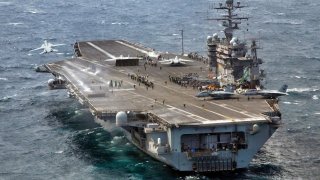Ford-Class vs. Nimitz-Class: A U.S. Navy Aircraft Carrier 'Showdown'
The Ford and Nimitz classes are America's most modern aircraft carriers, each with distinct advancements. The Nimitz uses a steam-powered catapult system, while the Ford features the more efficient Electromagnetic Aircraft Launch System (EMALS).
Summary and Key Points: The Ford and Nimitz classes are America's most modern aircraft carriers, each with distinct advancements. The Nimitz uses a steam-powered catapult system, while the Ford features the more efficient Electromagnetic Aircraft Launch System (EMALS).

-For landing, the Nimitz employs the MK 7 Aircraft Recovery System, whereas the Ford uses the Advanced Arresting Gear (AAG) system, designed to handle a wider range of aircraft with less maintenance.
-These differences highlight the technological evolution in carrier operations, improving sortie rates and reducing costs.
Ford-Class vs. Nimitz-Class: Aircraft Carriers from Different Generations
Since the invention of the aircraft carrier in the early twentieth century, the general design of the hallmark vessel has remained unchanged. Aircraft carriers are, invariably, a vessel built to transport, launch, and land aircraft.
Accordingly, aircraft carriers have a runway atop what is generally a massive hull with the capacity to house large crews, large amounts of aircraft, and all that is necessary to sustain both crew and aircraft. But, of course, the specifics can change from aircraft carrier to aircraft carrier. The runway. The launching system. The radar systems. The propulsion systems. The crew quarters. Plenty of opportunity for variation exists in what is functionally both a floating city and a floating air base.
Let’s take a look at the differences between America’s two most modern classes of aircraft carriers, the Ford and the Nimitz.
Launching System
Vital to the function of any aircraft carrier is the ability to launch aircraft. In the early days of aircraft carriers, prop planes would simply take off from the carrier deck, generating enough momentum and lift, of their own accord, to be able to take off within the length of runway that the aircraft carrier deck allowed. But modern American supercarriers, launching modern jets, rely on a catapult system. The catapult hitches to the jet’s wheel and slingshot the jet forward, building speed quickly and seamlessly.

The Nimitz and Ford have different types of catapult systems, however. The Nimitz relied upon a steam power catapult, which generated and harnessed steam to engage the catapult. The newer Ford dispelled with the Nimitz, in favor of the EMALS system.
The EMALS, or Electromagnetic Aircraft Launch System, is what the name implies: an electromagnetic catapult. The EMALS is an improvement over the traditional steam catapult, offering increased reliability and efficiency, with more accurate end-speed control and smoother acceleration. The result is a higher sortie rate, and over time, a cost reduction due to decreased manning and maintenance requirements.
Arresting Gear
What goes up must come down. The counterpoint of the launching system is the arresting gear used to safely land an aircraft back on an aircraft carrier’s deck. Easier said than done. Most modern runways are 5,000 to 8,000 feet long, allowing pilots a significant margin of error and plenty of space to decelerate their aircraft smoothly. Carriers, on the other hand, afford a pilot just 350 feet within which to land and halt their aircraft – which requires the assistance of an arresting gear.
On the Nimitz, landing aircraft were arrested with the MK 7 Aircraft recovery system. The MK 7 is a “hydropneumatics system composed of the engine structure, a cylinder and ram assembly, a crosshead and fixed sheaves…and cable arrangement.” The MK 7 is fairly ‘old school.’ The Ford operates with an updated arresting gear, the Advanced Arresting Gear System (AAG). The AAG uses rotary engines and water turbines paired with an induction motor; the AAG was built to handle a wider range of aircraft, with less manpower and less maintenance. The result is an arresting gear system that is more hands-off, yet can handle more aircraft.

So, despite outwardly appearing quite similar, the Ford and Nimitz have some crucial differences with respect to the nuts and bolts required to successfully complete carrier operations.
About the Author: Harrison Kass
Harrison Kass is a defense and national security writer with over 1,000 total pieces on issues involving global affairs. An attorney, pilot, guitarist, and minor pro hockey player, Harrison joined the US Air Force as a Pilot Trainee but was medically discharged. Harrison holds a BA from Lake Forest College, a JD from the University of Oregon, and an MA from New York University. Harrison listens to Dokken.
All images are Creative Commons.
More from National Interest
PAK DA - Russia Is Building a New Stealth Bomber
Houthis Might Have Attacked a Navy Aircraft Carrier - Report


